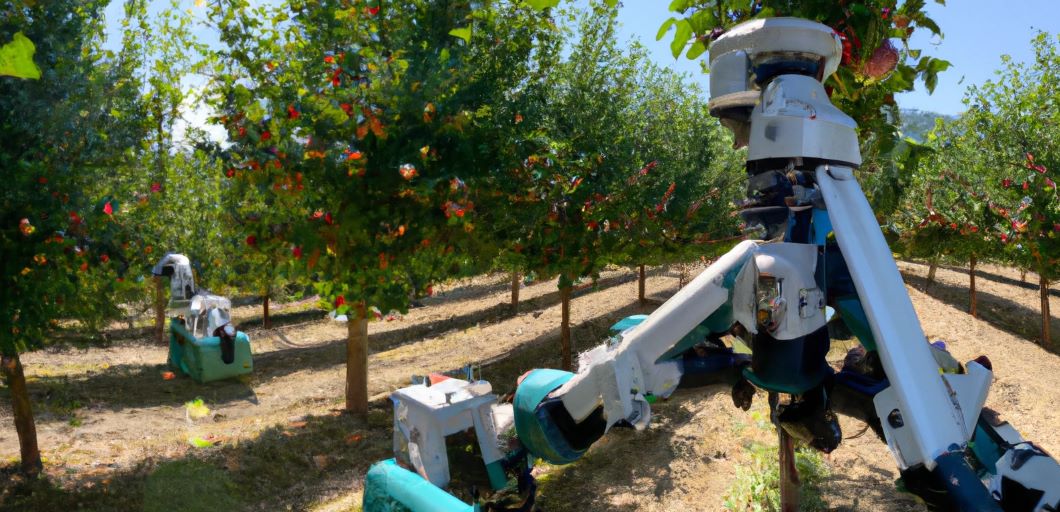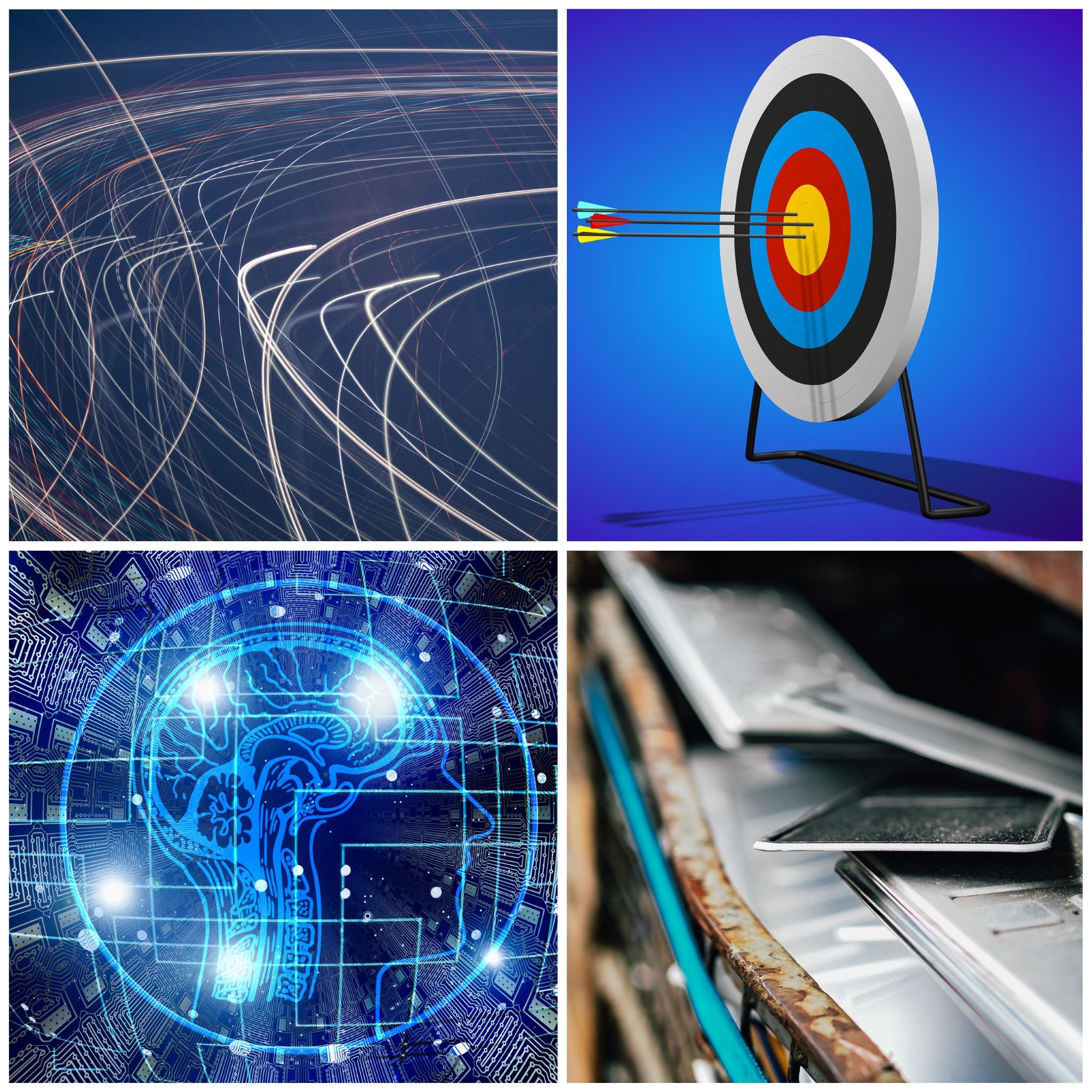The use of robots is no longer limited to the manufacturing industry. New applications in machine learning and robotics are changing the way fruit is grown and produced. Robotic fruit picking robots are not a new concept, and labor shortages are a perennial problem for fruit growers. There is a large focus on automating some of the more tedious jobs that will help growers get their crop to market.

These smart fruit picking machines are designed to automate labor intensive work, such as apple harvesting. These machines not only have the potential to change the way companies harvest, but also the way that trees are grown and maintained too.
The good news is that these autonomous fruit picking machines are getting more accurate, more efficient, and smarter every week. A few apple orchard robot pickers are even ready for action right now and within the next five years, we could see worldwide large-scale adoption of some of this technology. There are many automated fruit harvesting machines that are being developed and potentially many options for a grower to consider trialing or purchasing.
Here’s a quick rundown of what we found.
What is an autonomous fruit picking machine?
An autonomous fruit picking machine (AFPM) is a term for an orchard robot. Over the years there have been some spectacular failures and some promising tech. It is a hot topic of research right now, and even the US government is pouring millions of dollars into a new research program at the AgAID Institute. Check out the press release here from Washington State University.
Orchard robots have come to be judged by four criteria:
- Speed
- Accuracy
- Intelligence (application of intelligent computing theory)
- Durability

Speed
According to the International Journal of Advanced Robotic Systems, “Overall, the biggest problem in the research of apple harvesting robots is still the low harvesting efficiency.” Most apple harvesting robots are still slow compared to a human, but some can operate 24 hours a day which eventually increases efficiency even at slow speeds. Like the tortoise and the hair, the slow steadiness of a tireless machine will always win while the humans are limited to shifts and a maximum number of weekly work hours
Accuracy
The industry is highly focused on robotic accuracy and it is improving every day. Technologies from many other sectors, including visual processing, drone, tech, and advancements in robotic arms are all coming together to increase efficiency to the point where it is commercially available.
Intelligence
The smartest robotic apple picker automations can adapt to changing light and weather conditions and even learn from past decisions. This is the main reason people still need to be employed: solving problems and making decisions in the field.
Durability
A machine that breaks down all the time, or can not operate in low light or fog, for instance, will not be a sustainable solution for apple producers. A machine that succeeds in this changing market has to be robust and weatherproof.
The Best Automated Apple Pickers in 2022 (in alphabetical order).
- Abundant Robotics was the company's former name, reformed in 2021 under new ownership and leadership.
- Machine learning algorithms get smarter with every harvest.
- Now available in Washington State!
- Robotic arms and suction cup grippers to minimize bruising.
- Fresh Fruit Robotics CEO Avi Kahani says their apple orchard picking automation solution combines “precise yet simple robotic controls, fast and accurate image processing, and advanced algorithms for picking and distinguishing usable produce and damaged, diseased and unripe fruit.”
- Plus the harvester will be easily modified to pick different types of fresh fruit./li>
- The KUKA CropBot is designed for outdoor use.
- Lightweight construction
- This robot is based on the original “Munckhof Pluk-O-Truck” which was designed to help up to six workers harvesting in the field.
Tevel Aerobotics Technologies (in conjunction with Australian government)
- Flying autonomous robot (FAR) that identifies and picks the ripest fruit.
- It combines artificial intelligence with computer vision, advanced robotics, aeronautical engineering, and state-of-the-art flight control.
- Winner of the Agrifuture Concept Winner 2022 at AGRITECHNICA
Notable Ag-tech companies developing solutions for the apple industry in 2022
- Deploys an array of small, intelligent agriculture robots with advanced computer vision and robotics technology
- Autonomous collaborative robots to help solve the labor shortage
- Field robots that automate scouting, harvesting and weeding, and provides farmers with per-plant data for the whole life cycle of the plant
- Driverless tractors that use machine learning and computer vision to eradicate weeds from farmers’ fields
- New generation of field robots that help growers manage labor-intensive crops by automating fieldwork
Oxbo International Corporation:
- Innovative harvesting equipment
- Custom manufacturer of design-built harvesting aids, mechanical harvesting machines and specialized harvesting machines for the vegetable growing industry
- Focused on robotics and automation for sustainable growth of the horticultural industries
- Automates labor-intensive tasks for specialty growers
Traditional Orchard Architecture vs Robotic Orchard Architecture
Orchard robots work better when the trees are trimmed and trained to narrow incline trellises, or into small “cubes.” This makes it easier for the robotic arms and computer brains to pick the apples
Robotics are also required to enable an apple grower to create the best orchard architecture for robot apple harvesters.
The development of a scaffolding and trimming robot in the apple orchard goes all the way back to the 90’s. It’s worth noting that some of the most efficient apple picking machines being tested and developed depend on perfect orchard architecture. Though, to be fair, old, twisted trees or traditional (hand pruned) orchard architecture takes more time to harvest even for skilled human hands.
So, with changing tech and changing harvest methods it only makes sense that orchard architecture, tree maintenance, and even tree varieties will change too. Robotic pruners and harvesters will likely always rely on dwarf rootstocks and flat, vertical trellising that is present in robotic and non-robotic orchards.
Automation in the Apple orchard comes from many Developing Technologies
It seems like apple orchard automation should be a pretty straight-forward build. But, it turns out to be one of the great technological problems of our time. The reason is that robotic apple picking combines several technologies and making them work together is a challenge.
Robotic apple harvesters require the most advanced and gentle picker arms. They also need high quality image processing and accurate machine learning models.
Agricultural drones are being deployed to monitor crop growth and accurately predict yields.
The team that develops the best automated apple picking solution for large orchards will be the team that builds the whole new system of emerging and integrated technologies. Expect the bugs to be worked out in the next five to ten years.
Robotic apple harvesting robot future: Chicken or the egg?
Can you expect to run your orchard with a smartphone ten years from now? The answer, it seems, is probably.
It is probable, and even likely, that in ten years hand-harvested apples will be known as “artisan” or “craft” apples. If the present (2022) is the stage of the early adopter of the technology, the next decade will belong to the innovators, testers, tweakers, and tinkerers. A decade from now will be the stage where every grower will be involved or considering automated orchards.
Within the next five years we should see large-scale adoption of automated fruit picking machines, and other orchard robots whether we want it or not.
The main bottlenecks in the development of the fruit picking robots is machine learning, or teaching the robots. According to the International Journal of Advanced Robotic Systems, “supervised learning based on training data is still a major model training method. In the field of machine learning, more and more data is needed to improve the effectiveness of the model.” Just like humans, robots must learn before they are effective.
Like the conundrum of the chicken and the egg, the orchard industry seems to be “assembling in anticipation.” That is, there is evidence (and scholarly discussion) about how to best organize the future orchards with an eye to the technological future.
New apple varieties can not be created overnight and apple orchard layouts can not be reconfigured easily. As a result, large-scale growers are keeping an eye on robotic trends to try to get ahead.
Assembling in anticipation: orchard architecture, tree maintenance, and even tree varieties could change with the need for more dwarf rootstocks and flat, vertical trellising.
Robotics has the potential to revolutionize the apple industry as there is a chronic shortage of local agricultural workers in developed countries.
Labor issues come up in almost every discussion about farm management and potential automation. There is the potential for some workers to be displaced but there will be a demand for maintenance technicians in the field.
Key Takeaways
How does this affect you? Here are the key takeaways from this article.
Within the next five years we should see large-scale adoption of automated fruit picking machines. Expect the bugs to be worked out in the next five to ten years.
The most efficient apple picking machines being tested and developed depend on perfect orchard architecture.
Robotics has the potential to revolutionize the apple industry but also to possibly displace agricultural workers, but as this technology is adopted it will protect against labor and skill shortages
References
1. Baeten, J., Donné, K., Boedrij, S., Beckers, W., Claesen, E. (2008). Autonomous Fruit Picking Machine: A Robotic Apple Harvester. In: Laugier, C., Siegwart, R. (eds) Field and Service Robotics. Springer Tracts in Advanced Robotics, vol 42. Springer, Berlin, Heidelberg. https://doi.org/10.1007/978-3-540-75404-6_51
2. Jia, Weikuan & Zhang, Yan & Lian, Jian & Zheng, Yuanjie & Zhao, Demonio & Li, Chengjiang. (2020). Apple harvesting robot under information technology: A review. International Journal of Advanced Robotic Systems. 17. 172988142092531. 10.1177/1729881420925310
https://www.sciencedirect.com/science/article/pii/S0743016721000401
Croptracker develops agtech solutions for industry leaders. Located in Eastern Ontario, Canada, our mission is to make crop production safer, more efficient, and more profitable. Designed in partnership with fresh market producers and distributors, every tool we create is based on direct industry feedback. Croptracker’s award-winning farm software optimizes recordkeeping, labor tracking, production and cost management. Our integrative Harvest Quality Vision technology offers instant empirical analysis of crop samples exactly when you need it. Optimize your harvest season with Croptracker’s customizable solutions. Visit Croptracker.com to learn more about our products and contact us for a about app based solutions.

